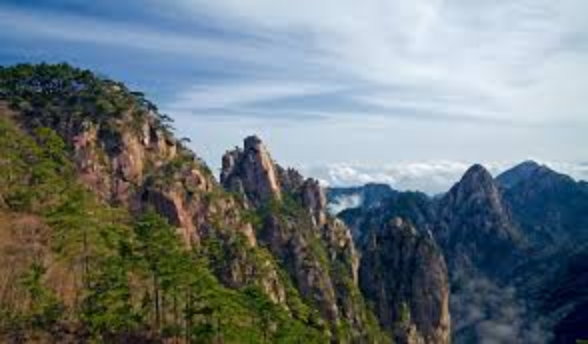
What is Mount Huangshan Famous For?
Mount Huangshan, often described as the “loveliest mountain of China”, has played an important role in the history of art and literature in China since the Tang Dynasty around the 8th century, when a legend dated from the year 747 described the mountain as the place of discovery of the long-sought elixir of immortality. Today, it is a UNESCO World Heritage Site and one of China’s most popular tourist destinations. But what exactly is Mount Huangshan famous for?
Natural Beauty
Known for its breathtaking scenery, Mount Huangshan boasts a landscape characterized by:
- Peculiarly shaped granite peaks: 72 peaks rise above 1,000 meters (3,281 feet), with the three tallest and best-known being Lotus Peak (Lianhua Feng), Bright Top Peak (Guangming Ding), and Celestial Capital Peak (Tiandu Feng). These granite peaks pierce the clouds, creating a truly awe-inspiring sight.
- Wondrous rocks: Formed by natural weathering and erosion over millions of years, the rocks on Mount Huangshan come in countless shapes and sizes, inspiring the imaginations of visitors. Many are named after their resemblance to humans, animals, or objects.
- Ancient pine trees: The area is home to numerous ancient pine trees, some over a thousand years old. These trees cling tenaciously to the rocky cliffs, their gnarled branches and twisted trunks adding to the scenery's picturesque quality.
- Hot springs: Scattered around the base of the mountain, these springs are known for their therapeutic properties. Rich in minerals, they offer a relaxing and rejuvenating experience.
- Sea of clouds: This breathtaking phenomenon occurs when a layer of clouds forms below the mountain peaks, creating the illusion of a sea with islands (the peaks) rising above it. It's a truly magical sight, especially stunning at sunrise and sunset.
Cultural Significance
Beyond its natural beauty, Mount Huangshan holds a significant place in Chinese culture:
- Inspiration for art and literature: For centuries, the mountain's inspiring scenery has been a muse for artists and poets. It features prominently in countless poems, paintings, and literary works, often depicted in a romanticized, almost mystical way.
- Subject of Huangshan painting school: The mountain's unique beauty gave rise to a distinct school of painting, known as the Huangshan School. This style, popular during the Ming and Qing dynasties, emphasized the use of light ink washes and bold brushstrokes to capture the area's atmospheric landscapes.
- Taoist heritage: Historically, Mount Huangshan was a center for Taoism. Numerous temples and hermitages were built on its slopes, attracting those seeking spiritual enlightenment amidst the serene surroundings.
Hiking and Exploration
Mount Huangshan offers fantastic opportunities for hiking and exploration:
- Well-maintained trails: A network of well-maintained trails caters to different fitness levels, from gentle paths to challenging climbs. Some trails lead to stunning viewpoints, while others wind through picturesque forests and valleys.
- Cable cars: For those who prefer a less strenuous ascent, cable cars are available to reach some of the higher peaks, providing breathtaking views along the way.
- Accommodation options: The mountain offers various accommodation options, from basic guesthouses to more comfortable hotels. Staying overnight allows visitors to witness the magical sunrise and sunset over the peaks.
Tourism and Accessibility
Mount Huangshan is well-equipped to receive visitors from around the world:
- Accessibility: The mountain is easily accessible by road and rail from major cities like Shanghai, Hangzhou, and Nanjing.
- Visitor facilities: The scenic area is well-developed, with visitor centers, restaurants, and shops available.
- Guided tours: Guided tours are available for those who want to learn more about the area's history, culture, and natural wonders.
| Attraction | Description | Must-see for |
|---|---|---|
| Lotus Peak (Lianhua Feng) | Highest peak, offering panoramic views | Hikers, photography enthusiasts |
| Bright Top Peak (Guangming Ding) | Known for its spectacular sunrises | Early birds, photographers |
| Celestial Capital Peak (Tiandu Feng) | Steep climb rewarded with stunning scenery | Adventurous hikers, experienced climbers |
| Welcome Pine (Ying Ke Song) | Iconic, strangely shaped pine tree | Nature lovers, photographers |
| Beginning-to-Believe Peak (Shixin Feng) | Offers breathtaking views of the surrounding peaks | Hikers, photographers |
| Hot springs at the base of the mountain | Relaxing and therapeutic experience | Those seeking relaxation, wellness enthusiasts |
FAQs
What is the best time to visit Mount Huangshan?
Spring and autumn offer pleasant weather and fewer crowds. Summer can be hot and humid but provides stunning views of the sea of clouds. Winter sees fewer visitors but can be very cold with potential for snow.
How long should I plan for a visit to Mount Huangshan?
Plan for at least two full days to fully experience the mountain's highlights, including hiking to the peaks, enjoying the scenery, and exploring the cultural sites.
Is Mount Huangshan suitable for families with children?
While Mount Huangshan offers spectacular views and hiking trails, some trails can be steep and challenging. Families with young children should choose easier routes and consider using cable cars.